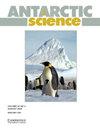Lithostratigraphy, age and distribution of Eocene volcanic sequences on eastern King George Island, South Shetland Islands, Antarctica
IF 2
4区 地球科学
Q3 ENVIRONMENTAL SCIENCES
引用次数: 8
Abstract
Abstract New mapping and dating of volcanic outcrops on the east coast of Admiralty Bay, King George Island, has demonstrated that Eocene volcanic sequences are dominant and also crop out extensively elsewhere, particularly on the eastern part of the island. The sequences can be divided into at least three formations (Hennequin, Cape Vauréal and Carruthers Cliff) together with Eocene strata at Warkocz and near Lions Rump that are currently unassigned stratigraphically. New and recently published 40Ar/39Ar ages indicate that all of the formations are Early Eocene in age, mainly Ypresian, extending to Lutetian and possibly even Priabonian time in more easterly outcrops. Compositional contrasts exist between the groups (calc-alkaline vs tholeiitic). The formations are mainly composed of lavas, and many show evidence for contemporary inundation by water. They are interbedded with sedimentary rocks deposited mainly during flooding events as debris flows, debris avalanches, hyperconcentrated flows, from traction currents and in lakes. The common presence of juvenile volcanic detritus suggests that the sediments were probably linked to explosive hydrovolcanic eruptions, some of which were possibly rooted in summit ice caps. Other evidence is also permissive, but the presence of Eocene ice on King George Island is not well established at present.南极洲南设得兰群岛乔治王岛东部始新世火山层序的岩石地层学、年龄和分布
摘要乔治王岛金钟湾东海岸火山露头的新测绘和测年表明,始新世火山序列占主导地位,在其他地方也广泛出现,特别是在该岛东部。该层序可分为至少三个地层(Hennequin、Cape Vauréal和Carruthers Cliff),以及Warkocz和Lions Rump附近的始新世地层,这些地层目前尚未进行地层划分。新的和最近公布的40Ar/39Ar年龄表明,所有地层的年龄都是早始新世,主要是伊普雷西阶,延伸到卢特阶,甚至可能在更东部的露头中延伸到普里亚博阶。各组之间存在成分对比(钙碱性与拉斑玄武岩)。地层主要由熔岩组成,许多地层显示出当代被水淹没的证据。它们与沉积岩互层,沉积岩主要在洪水事件期间沉积,如泥石流、泥石流、高浓度流、牵引流和湖泊。幼年火山碎屑的普遍存在表明,沉积物可能与爆炸性的水火山喷发有关,其中一些可能植根于山顶冰盖。其他证据也是允许的,但乔治王岛上始新世冰的存在目前还没有得到很好的证实。
本文章由计算机程序翻译,如有差异,请以英文原文为准。
求助全文
约1分钟内获得全文
求助全文
来源期刊

Antarctic Science
地学-地球科学综合
CiteScore
3.60
自引率
6.20%
发文量
42
审稿时长
3 months
期刊介绍:
Antarctic Science provides a truly international forum for the broad spread of studies that increasingly characterise scientific research in the Antarctic. Whilst emphasising interdisciplinary work, the journal publishes papers from environmental management to biodiversity, from volcanoes to icebergs, and from oceanography to the upper atmosphere. No other journal covers such a wide range of Antarctic scientific studies. The journal attracts papers from all countries currently undertaking Antarctic research. It publishes both review and data papers with no limits on length, two-page short notes on technical developments and recent discoveries, and book reviews. These, together with an editorial discussing broader aspects of science, provide a rich and varied mixture of items to interest researchers in all areas of science. There are no page charges, or charges for colour, to authors publishing in the Journal. One issue each year is normally devoted to a specific theme or papers from a major meeting.
 求助内容:
求助内容: 应助结果提醒方式:
应助结果提醒方式:


